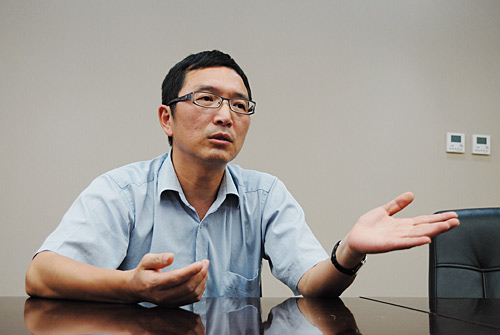|
 |
|
Yuan Shiyun (JIN DUOYOU) |
The mention of Chongqing, a municipality in southwest China, often conjures up images of well-known tourist attractions like the Three Gorges of the Yangtze River, the scenery of the Wujiang River, and the Dazu Stone Carving. But in the 1970s and 1980s, underdeveloped transportation in the "mountainous city" made it difficult to visit these places.
"The infrastructure of the city's tourism industry was fairly weak, because the number of qualified travel agencies couldn't keep up with the increase in tourists," recalled Yuan Shiyun, manager of the Europe Division at the Chongqing Overseas Tourism Group Corp. Ltd. .
Yuan, 45, has been working at the Group since he graduated from the Shanghai Foreign Language Institute (now known as Shanghai International Studies University) in 1986.
"Transportation is the first and foremost problem in developing the tourism industry, because even the best tourist site will wither away if no one visits it," Yuan told Beijing Review.
In 1996, the Chengdu-Chongqing Expressway was built, reducing the time it took to travel the 170 km between Chongqing and Dazu from five hours to two hours. The expressway enabled a tour group to return on the same day, which greatly promoted travel efficiency and reduced travel costs.
Cruise ships are one of the best ways to see the Yangtze River, but they were in short supply in the 1980s. Only a few poorly-maintained transport vessels were available to domestic and foreign travelers, who boarded the boats with Chongqing natives traveling on their own business. Often a slightly decorated ship would be employed to take tourists to ease the traffic tension.
Things are quite different now. There are now 50 luxury cruise ships catering to tourists in high seasons. Passenger capacity for each ship has increased from 100 to 300, and narrations and performances are available on board. "It is just beyond anything we could have imagined in the past," said Yuan.
The improvement of accommodation conditions in Chongqing has also made a deep impression on Yuan. In 1986, only a few state-owned hotels in Chongqing were provided for foreign visitors, such as Chongqing Hotel, the People's Hotel and Yuzhou Hotel. They were only equivalent to today's three-star standard hotels.
The Holiday Inn Yangtze Chongqing, the first international standard hotel in the city, was built in 1989, reorienting the city's hotel industry to meet international standards. International hotel management groups introduced a series of mature management systems and service standards to the city's hotels, which greatly improved Chongqing's local hotel standards.
"It was hard to reserve a standard room at the Holiday Inn Yangtze Chongqing back then, which charged $70 a day, a relatively expensive amount even for foreign travelers. But now, five-star standard hotels can be found everywhere, and four-star standard is the lowest hotel standard for receiving foreign visitors," said Yuan.
In 1989, the city established the Chongqing Tourism Administration, which meant that tourism would be promoted as an industry. By 1997, the tourism industry in Chongqing had made great strides. Statistics showed that the number of foreign visitors was 200,000 that year, while the number of domestic visitors was 18.5 million, a rise of 4.1 times and 3.7 times, respectively, compared with the figures in 1989. The city's income from tourism totaled 7.34 billion yuan ($885 million), a rise of 164.5 times compared with that in 1989.
On March 14, 1997, Chongqing was approved a municipality directly under the Central Government at the Fifth Session of the Eighth National People's Congress, becoming the fourth one following Beijing, Shanghai and Tianjin.
"The Chongqing Municipal Government decided to seize the opportunity to develop its tourism industry into a new pillar industry," said Wang Aizu, Director of the Chongqing Tourism Administration.
Chongqing set up a tourism industry leading group in 1997 and passed related management regulations. Moreover, the Chongqing Government specifically allocated 30 million yuan ($3.6 million) from its 5 billion yuan ($603 million) budget to develop the tourism industry. These moves spurred rapid development of the city's tourism industry from 1997 to 2008, according to Wang.
In recent years the city has focused on providing more variety, adding leisure tourism, cruise tourism and hot spring tourism. "Tourism is becoming a new engine to drive consumption and the local economy," said Wang.
Background
Chongqing, known as Yu for short, is located in the transitional area between the Qinghai-Tibet Plateau and the plains area on the middle and lower reaches of the Yangtze River. Located at the juncture of the Jialingjiang and Yangtze rivers, Chongqing features crisscrossing rivers and mountains, including parts of the world-famous Three Gorges--Qutang Gorge, Wuxia Gorge, and Xiling Gorge. Chongqing now has 226 star-standard hotels, 27 international travel services and 282 domestic travel agencies. It is also home to two world heritage sites, the Dazu Stone Carving and the Wulong Karst, two state 5A-class tourist scenic spots, and 29 national 4A-grade scenic spots. | 
